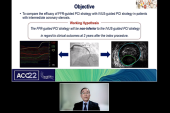FLAVOUR Confirms Long-term Noninferiority of FFR vs IVUS to Guide PCI
Researchers say the data further support the use of an FFR-first strategy in treating intermediate coronary lesions.

PARIS, France—Even several years after intervention, fractional flow reserve (FFR)-guided PCI remains as safe and effective as IVUS-guided PCI when it comes to managing intermediate coronary lesions, according to extended follow-up from the FLAVOUR trial presented at EuroPCR 2025.
FLAVOUR, as reported by TCTMD, initially showed the equivalence of assessing either physiology or anatomy in terms of a patient-oriented composite endpoint that included death from any cause, MI, and any revascularization at 24 months. FFR guidance also resulted in fewer stents implanted.
While researchers at the time indicated the trial’s main data were supportive of an FFR-first strategy in these patients, lead investigator Bon-Kwon Koo, MD, PhD (Seoul National University Hospital, Republic of Korea), last week said that concern over the follow-up being too short was understandable given that longer-term outcomes in other trials of similar patient populations “show late catch-up or delayed divergence of survival curves.”
The latest findings for 1,602 patients—95% of the original cohort—followed out to a median of 6.3 years confirm that FFR should be the default tool to guide PCI in these cases, he argued.
“FFR will show a higher rate of late target vessel revascularization. However, the overall target vessel PCI burden remains significantly lower in the FFR group,” Koo said. “So therefore, these long-term follow-up results support FFR as a strategy that can reduce PCI burden without compromising long-term safety and efficacy in patients with intermediate lesions.”
Discussing the study during the session, David Erlinge, MD, PhD (Skane University Hospital, Lund, Sweden), said FLAVOUR “has a very, very intelligent design because it really uses those two entities—FFR and IVUS—both for deciding on whether to revascularize and to evaluate post-stenting results. Usually, people use FFR to decide on revascularization, but don’t use it to check post-stenting results, and they use IVUS to optimize the stenting, but they don’t use it to decide on revascularization. So, it really gives both methods the best way to give information to the operators.”
Long-term FLAVOUR Results
For the analysis, Koo and colleagues included long-term follow-up from 95.2% of the original FLAVOUR cohort (mean age 65.1 years; 70.6% male). Notably, more patients in the IVUS group were taking DAPT at discharge (71.8% vs 58.1% with FFR; P < 0.001) and at 2 years (31.5% vs 24.7%; P = 0.002), but this difference was no longer significant at last follow-up (15.2% vs 11.9%; P = 0.065).
Patients assigned to FFR-guided PCI had a similar rate of the primary endpoint as those randomized to IVUS-guided procedures (23.0% vs 20.9%; HR 0.88; 95% CI 0.71-1.09). This finding held in a landmark analysis from 2 to 7 years after randomization (HR 0.78; 95% CI 0.59-1.03).
Looking at the individual components of the primary endpoint, rates of all-cause death and MI were both similar between the study arms. However, those in the FFR group did have a greater risk of any revascularization over follow-up (14.9% vs 11.8%; HR 0.76; 95% CI 0.57-1.00), most of which happened between 2 and 7 years after randomization (HR 0.64; 95% CI 0.43-0.94).
Physiology and morphology seem to be equally important. David Erlinge
Among vessels that were treated with medication, the rate of target vessel revascularization was higher over time in patients who received FFR compared with IVUS (9.5% vs 5.6%; P = 0.046), but this was not seen in the PCI-treated vessels.
Finally, the overall PCI burden in target vessels was lower in the FFR group compared with the IVUS group over follow-up without any difference in the rate of death or MI.
Because more PCIs were observed in the IVUS group, Erlinge said the study “illustrates an important principle: FFR might be preferable if you want to reduce unnecessary PCI without compromising the long-term outcome, but IVUS could be more appropriate if you want to reduce future coronary events and probably treat some of those vulnerable plaques in the body.”
While FFR is shown to be noninferior to IVUS, the reverse is also true, he highlighted. “Physiology and morphology seem to be equally important.”
Yael L. Maxwell is Senior Medical Journalist for TCTMD and Section Editor of TCTMD's Fellows Forum. She served as the inaugural…
Read Full BioSources
Koo B-K. Long-term outcomes after imaging and physiology-guided PCI: extended follow-up of FLAVOUR trial. Presented at: EuroPCR 2025. May 22, 2025. Paris, France.
Disclosures
- The FLAVOUR extended follow-up study was supported by Yuhan Pharmaceutical.
- Koo reports receiving institutional research grants from Abbott Vascular, Boston Scientific, Philips, and Yuhan Pharmaceutical.





Caitlin Cox
Sasha Koul